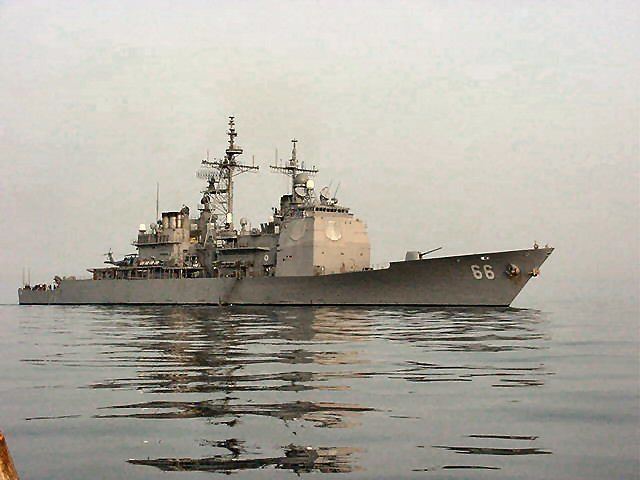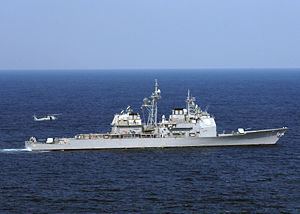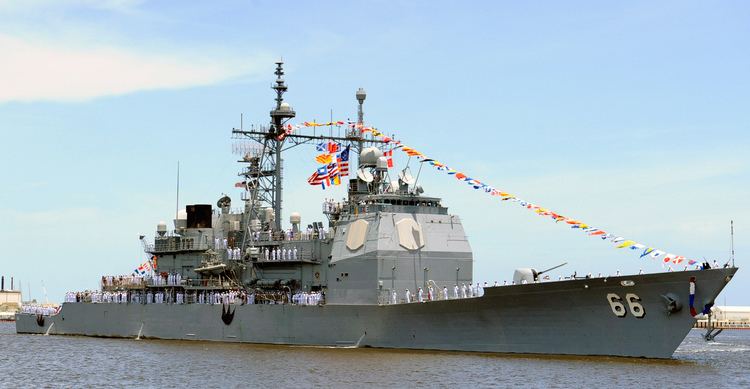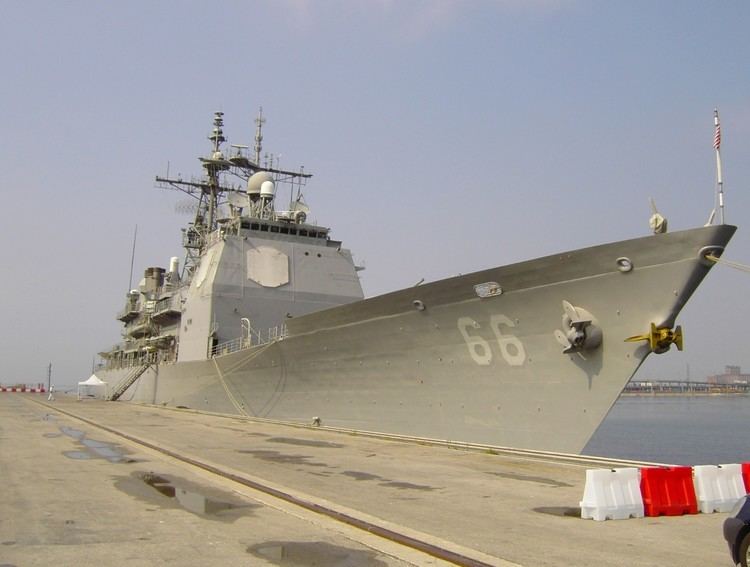Name USS Hué City Laid down 20 February 1989 Construction started 20 February 1989 Length 173 m Beam 17 m | Namesake Battle of Hue Ordered 16 April 1987 Acquired 28 June 1991 Launched 1 June 1990 Draft 10 m | |
 | ||
Uss hu city conducts a live fire exercise
USS Hué City (CG-66) is a Ticonderoga class-guided-missile cruiser serving in the United States Navy. She is named for the Battle of Hue, fought in the city during the Tet Offensive 1968 by the 1st Marine Regiment (composed of 1st Battalion/1st Marines, 1st Battalion/5th Marines, 2nd Battalion/5th Marines and attached units) during the Vietnam War. The three battalion commanders were the honored guests at her 1991 commissioning.
Contents
- Uss hu city conducts a live fire exercise
- History
- 1990s
- 2000s
- 2010s
- Awards
- In Fiction and Literature
- References

Hué City is the only U.S. Navy ship named after a battle in the Vietnam War, although it had been planned to name LHA-5 as USS Khe Sanh after the Battle of Khe Sanh, but that ship was commissioned in 1976 as USS Peleliu. As the only U.S. warship named for a battle that took place during the Vietnam War, Hué City has had the opportunity to reach out to the veterans of the battle for which she is named. She has done so frequently by holding a Memorial for the Battle of Hué annually every year the ship's schedule permits. The Memorial has served as a great opportunity for veterans to re-unite, meet the crew, and honor their fallen comrades.

History
Hué City was ordered 16 April 1987 and laid down 20 February 1989 at Ingalls Shipbuilding, Pascagoula, Mississippi. Hué City was commissioned 14 September 1991, Captain Thomas Irvin Eubanks in command.
1990s

Hué City sailed on 11 March 1993 for her maiden Deployment to the Mediterranean Sea as Air Warfare Commander for the USS Theodore Roosevelt (CVN-71) battle group. Principally operating in the Adriatic Sea, Hué City developed the air picture and transmitted it to command centers afloat and shore. Hué City also monitored the safety of United Nations relief flights to Bosnia, ensuring Serbian aircraft did not violate no-fly zones.

While conducting training near Guantanamo Bay, Cuba, in April 1994 Hué City was directed to serve as Destroyer Squadron 22 flagship in support of sanctions against Haiti. Hué City sailed for her second deployment 22 March 1995 with the Theodore Roosevelt battle group. Hué City took station in the Red Sea, where she provided air coverage to the Combat Air Patrol enforcing the no-fly zone in Southern Iraq.

Hué City sailed for the Baltic Sea on 24 May 1996 to participate in operations involving forty-eight ships from thirteen nations. The operations focused on tracking air, surface, and subsurface targets in a multinational task force. Hué City deployed on 29 April 1997 to the Mediterranean Sea as Air Warfare Commander for the USS John F. Kennedy battle group. Hué City operated in the Adriatic Sea, overseeing all air activity in support of naval operations.
In 1999 Hué City sailed for counter-drug operations in the Caribbean Sea. Later that year, Hué City participated in Baltic Operations, a multinational exercise consisting of fifty-three vessels from twelve nations.
2000s
Hué City conducted multinational exercises in South America while acting as flagship in UNITAS 2000 Caribbean phase. On 26 June 2000 Hué City sailed to New York City as the reviewing ship for President Clinton and his family, Secretary of Defense, Secretary of the Navy, Chief of Naval Operations, Commandant of the Marine Corps, and COMCRUDESGRU 12 in the International Naval Review 2000.
As part of the USS George Washington (CVN-73) Carrier Battle Group (CVBG), and in response to the terrorist attacks of September 11, 2001, Hué City set sail in support of defense and humanitarian efforts off the coast of New York.
Ships and aircraft of the USS John F. Kennedy (CV-67) Carrier Battle Group (CVBG) commenced use of the Vieques Island inner range beginning 24 September 2001 in conjunction with their Composite Unit Training Exercises (COMPUTEX). The exercise, which began the week prior, also utilized the northern and southern Puerto Rican operating areas, and involved complex battle group training events, naval surface fire-support training and air-to-ground bombing.
Hué City then took part in Underway No. 10, one in a series of tests leading to the Cooperative Engagement Capability (CEC) Operation Evaluation (OPEVAL) scheduled for Spring 2001. The CEC system provides the capability to cooperatively engage targets by a warship using data from other CEC-equipped ships, aircraft, and land-based sensors, even in an electronic-jamming environment. It also provides a common, consistent and highly accurate air picture, allowing battle group defenses to act as one seamless system. The test, off Wallops Island, Virginia, simulated missile firings from some of the Navy's most technically advanced ships against unmanned drones.
As part of the USS John F. Kennedy (CV-67) Battle Group, Hué City took part Joint Task Force Exercise (JTFEX) 02-1, with Phase I of the exercise running from January 19 through 26, 2002 and Phase II running 7–14 February 2002.
In March 2002, Hué City was part of USS John F. Kennedy (CV-67) Carrier Battle Group at it relieved USS Theodore Roosevelt (CVN-71) Carrier Battle Group, in support of Operation Enduring Freedom.
In May 2002, during a three-day Naval Gun Fire Support (NGFS) exercise off the coast of Djibouti, Africa, Hué City fired hundreds of 5-inch rounds in support of Marine Expeditionary Unit Exercise 2002 (MEUEX '02) more than 60 targets that included tanks, bunkers, and various military vehicles. Hué City joined the USS Wasp (LHD-1) Amphibious Ready Group (ARG) and the 22nd Marine Expeditionary Unit to conduct this first of its kind exercise in this little-known region of northeast Africa.
Prior to 2014, she successfully completed consecutive deployments to the Persian Gulf and North Arabian Sea.
2010s
On 14 April 2014, Monday evening, a fire broke out at just after 6:20 p.m. local time while Hué City was steaming about 200 nautical miles northeast of Bermuda. The crew fought and defeated a major fire in one of the main engineering spaces without suffering any injuries. The ship's executive officer was relieved by the head of Carrier Strike Group 8 in June 2014 for "failing to ensure his crew properly stowed hazardous materials" which subsequently caught fire. According to the investigation report, bales of rags caught fire after they had been improperly stored in an exhaust uptake trunk. The fire caused over $23 million in damage forcing over 9 months of repairs. It also caused Hué City to miss the planned deployment to Europe .
Awards
According to the Navy unit Awards site, Hué City received the following awards:
In Fiction and Literature
USS Hué City (CG-66) is mentioned in Djibouti: A Novel, by Elmore Leonard, 2010. USS Hué City is also mentioned in passing in the 2011 naval thriller, Thunder in the Morning Calm, by Don Brown.
